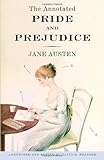 I first read Pride and Prejudice during my first year teaching (which was 1997-1998, and I know it was 1998 when I read the novel). I fell in love with Jane Austen that year. Despite my affection for Ms. Austen, I had not re-read any of her novels, though I have watched adaptations in film. I decided I was overdue for a re-read of Pride and Prejudice, and this annotated version of the novel appealed to the scholar in me. I had hoped to learn some new interesting things or gain new insights from the David Shapard’s annotations, and I was not disappointed.
I first read Pride and Prejudice during my first year teaching (which was 1997-1998, and I know it was 1998 when I read the novel). I fell in love with Jane Austen that year. Despite my affection for Ms. Austen, I had not re-read any of her novels, though I have watched adaptations in film. I decided I was overdue for a re-read of Pride and Prejudice, and this annotated version of the novel appealed to the scholar in me. I had hoped to learn some new interesting things or gain new insights from the David Shapard’s annotations, and I was not disappointed.
In some cases, the annotations were repetitive (for example, for each reference to “town,” Shapard reminds the reader that “town” refers to London). However, learning the differences between the different types of carriages, gaining insight into the conventions of the day, and so much more that I can’t possibly list it all here really enhanced my enjoyment of the book. I am currently listening to Jonathan Strange & Mr. Norrell, and I find that the annotations in Pride and Prejudice have enhanced my enjoyment of that novel, too—after all, it owes a great deal to Jane Austen. A sojourn in Jane Austen’s novels is always rewarding, and I wonder if it’s possible to feel homesick for a place you’ve never even been except in books.
If you haven’t seen the new blog Following Jane, you might want to check it out. It’s interesting to read the perspectives of man dedicating himself to reading all of Jane Austen’s novels and blogging about his experiences. In a recent post written before he started Northanger Abbey, his first selection, he mentioned he was anxious to finish the book he had been reading at the time so that he could start reading Austen. I know that feeling. As I reach the end of the book, my thoughts are turning toward my next read, which will be A Year in the Life of William Shakespeare: 1599 by James Shapiro. All the talk about Shapiro’s new book, Contested Will: Who Wrote Shakespeare?, has inspired quite a lot of quick reviews of A Year in the Life, which I have on my shelf and haven’t read. Austen and Shakespeare, my two favorite authors. How I’d love to sit down and have tea with them both.

Pride and Prejudice is my fourth selection for the Typically British Challenge, and concludes the “Gordon Bennett” level of four novels that I committed to read. I may read other British authors over the course of the year (the challenge expires on December 31), but I can claim for the first time ever that I actually finished a reading challenge.
Dana – this is more a response to your blog overall. I love the way social media and networking can be put to use to guide readers into more reading, and more of the classics. Will Web 2.0, or 3.0, or whatever follows, be the death of books as some fear, or their salvation?
I have this to say, which is purely anecdotal. I never read as much as I have since I started this blog because I feel like I should update it with reviews and discussion of what I'm reading. I also have a record of everything I've read (practically) for the last several years. I get great recommendations from other book bloggers and teachers, too. So I say whatever Web 2.0 will do, it won't kill reading. I hope it will encourage reading, but I can't say it necessarily will. I do think those who like to read and share what they read have been given one more avenue for doing so and perhaps even an audience they wouldn't have had. I find that encouraging.
You know, I never wanted to read an annotated P&P for P&P's sake, but you're kind of making me want to read it to shed light on Jonathan Strange & Mr. Norrell. I bet it would be useful!
I can't remember exactly what it was, but I remember that something was mentioned, and I recalled "Oh, they explained all about that in the Annotated P&P." Your mileage may vary, of course, but I enjoyed the book.
I own 3 copies of Pride and Prejudice and this annotated version is my favorite.
Emma, you inspired a post! Check it out here if you are interested.